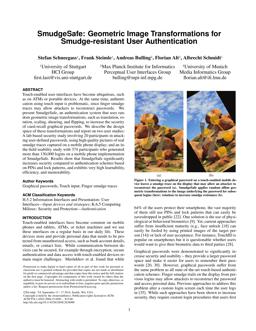SmudgeSafe
Touch-enabled user interfaces have become ubiquitous, such as on ATMs or portable devices. At the same time, authentication using touch input is problematic, since finger smudge traces may allow attackers to reconstruct passwords. We present SmudgeSafe, an authentication system that uses random geometric image transformations, such as translation, rotation, scaling, shearing, and flipping, to increase the security of cued-recall graphical passwords. We describe the design space of these transformations and report on two user studies: A lab-based security study involving 20 participants in attacking user-defined passwords, using high quality pictures of real smudge traces captured on a mobile phone display; and an inthe-field usability study with 374 participants who generated more than 130,000 logins on a mobile phone implementation of SmudgeSafe. Results show that SmudgeSafe significantly increases security compared to authentication schemes based on PINs and lock patterns, and exhibits very high learnability, efficiency, and memorability
Publikationen
 |
Stefan Schneegass, Frank Steimle, Andreas Bulling, Florian Alt und Albrecht Schmidt. SmudgeSafe: Geometric Image Transformations for Smudge-resistant User Authentication. In Proceedings of the 2014 ACM International Joint Conference on Pervasive and Ubiquitous Computing. UbiComp '14. ACM, New York, NY, USA. [Download Bibtex] |